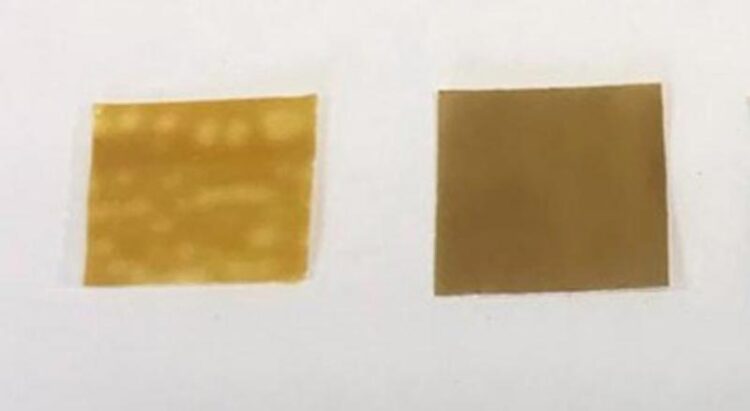Metal-organic frameworks could someday deliver antibacterial nitric oxide

Membrane films containing MOFs, like those shown here, that produce nitric oxide could provide antibacterial properties in medical devices.
Credit: Adapted from ACS Applied Materials & Interfaces 2023, DOI: 10.1021/acsami.3c11283
Because metal-organic frameworks (MOFs) — highly porous metal complexes — are so structurally and chemically diverse, they could be used for many applications, such as drug delivery and environmental clean-up.
But researchers still need to get a better understanding of how they function, especially when embedded in polymers. Reporting in ACS Applied Materials & Interfaces, researchers have now developed and characterized nitric oxide (NO)-storing MOFs embedded in a thin film with novel antibacterial potential.
Studying the interactions between MOFs and polymers within membranes can be challenging and requires complex analytical methods and significant resources. In earlier studies, Russell E. Morris and colleagues examined the interface between a nickel-containing MOF and polyurethane. But the focused-ion-beam scanning electron microscopy (FIB-SEM) method that they used can alter or damage both polymers and MOFs. So, the same researchers together with Zeiss Microscopy used a new FIB-SEM technique using cryogenics to increase stability of MOF composites.
To test this, they created three membranes in collaboration with researchers at Colorado State University containing a nickel MOF called CPO-27-Ni, a copper MOF called CuBTTri, or both. Next, using their cryogenic FIB-SEM technique, they saw particles of each MOF in greater detail than with other imaging methods. The images also showed that the metal complexes were distributed evenly throughout the membranes and did not overlap. The researchers then examined the ability of the films to release NO, a molecule with antibacterial properties that could have biomedical applications. In experiments, MOF-embedded membranes had different triggers and responses:
- CPO-27-Ni released NO quickly, as a short burst, in response to moisture.
- CuBTTri acted as a catalyst when exposed to a tripeptide, S-nitrosoglutathione (GSNO), a natural source of NO in the human body, and produced a sustained NO release in response.
- Together, CPO-27-Ni and CuBTTri yielded a membrane with rapid and sustained NO delivery, when exposed sequentially to moisture and to GSNO.
The researchers say that the nickel and copper MOFs combined to create a composite material that achieved an optimal, two-stage NO delivery system. They suggest that this two-phase delivery might be useful in medical devices, providing both immediate antibacterial effects and long-term prevention of microbial fouling.
The authors acknowledge funding from the European Research Council grant ADOR, the EPSRC Light Element Analysis Facility Grant, and the EPSRC Strategic Equipment Resource Grant.
The paper’s abstract will be available on Oct. 11 at 8 a.m. Eastern time here: http://pubs.acs.org/doi/abs/10.1021/
The American Chemical Society (ACS) is a nonprofit organization chartered by the U.S. Congress. ACS’ mission is to advance the broader chemistry enterprise and its practitioners for the benefit of Earth and all its people. The Society is a global leader in promoting excellence in science education and providing access to chemistry-related information and research through its multiple research solutions, peer-reviewed journals, scientific conferences, eBooks and weekly news periodical Chemical & Engineering News. ACS journals are among the most cited, most trusted and most read within the scientific literature; however, ACS itself does not conduct chemical research. As a leader in scientific information solutions, its CAS division partners with global innovators to accelerate breakthroughs by curating, connecting and analyzing the world’s scientific knowledge. ACS’ main offices are in Washington, D.C., and Columbus, Ohio.
To automatically receive news releases from the American Chemical Society, contact newsroom@acs.org.
Journal: ACS Applied Materials & Interfaces
DOI: 10.1021/acsami.3c11283
Article Title: Mixed Metal-Organic Framework Mixed-Matrix Membranes: Insights into Simultaneous Moisture-Triggered and Catalytic Delivery of Nitric Oxide using Cryo-scanning Electron Microscopy
Article Publication Date: 11-Oct-2023
Media Contacts
ACS Newsroom
American Chemical Society
newsroom@acs.org
Emily Abbott
American Chemical Society
e_abbott@acs.org
All latest news from the category: Life Sciences and Chemistry
Articles and reports from the Life Sciences and chemistry area deal with applied and basic research into modern biology, chemistry and human medicine.
Valuable information can be found on a range of life sciences fields including bacteriology, biochemistry, bionics, bioinformatics, biophysics, biotechnology, genetics, geobotany, human biology, marine biology, microbiology, molecular biology, cellular biology, zoology, bioinorganic chemistry, microchemistry and environmental chemistry.
Newest articles

Roadmap to close the carbon cycle
A holistic approach to reach net-zero carbon emissions across the economy. A major approach to achieving net-zero carbon emissions relies on converting various parts of the economy, such as personal…

Cost-effective, high-capacity, and cyclable lithium-ion battery cathodes
Charge-recharge cycling of lithium-superrich iron oxide, a cost-effective and high-capacity cathode for new-generation lithium-ion batteries, can be greatly improved by doping with readily available mineral elements. The energy capacity and…

New regulator of eating behaviour identified
The rapidly escalating prevalence of overweight and obesity poses a significant medical challenge worldwide. In addition to people’s changing lifestyles, genetic factors also play a key role in the development…





















